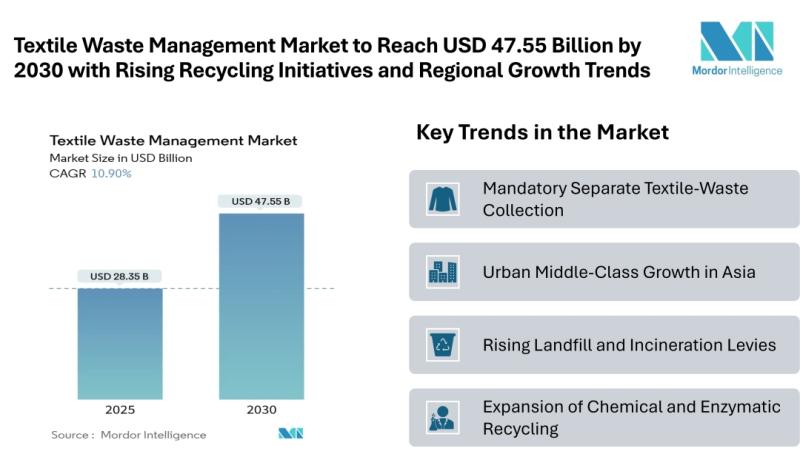NIIMBL Announces Project Call 9.1 – New Funding Available for Biopharma Innovation – PR Newswire

Report on NIIMBL Project Call 9.1: Advancing Biopharmaceutical Manufacturing Through Sustainable Development Goals
Introduction
The National Institute for Innovation in Manufacturing Biopharmaceuticals (NIIMBL) has announced Project Call 9.1, a strategic initiative to advance the biopharmaceutical manufacturing sector in the United States. A total of $8 million, comprising NIIMBL funding and participant co-investment, is allocated for this call. The initiative seeks to fund projects in technology and workforce development that directly contribute to several key United Nations Sustainable Development Goals (SDGs). The deadline for concept submissions by NIIMBL members is September 16, 2025.
Alignment with Sustainable Development Goals (SDGs)
This project call is fundamentally aligned with the global agenda for sustainable development by targeting innovation, health, education, and economic growth. The initiative’s impact is projected across the following SDGs:
- SDG 3: Good Health and Well-being: By accelerating the development of innovative manufacturing technologies, the project aims to enhance patient access to life-saving biopharmaceuticals, directly supporting targets for universal health coverage and well-being.
- SDG 4: Quality Education: The workforce development component is designed to create inclusive and equitable training and career pathways, building a skilled labor force prepared for the future of the industry and promoting lifelong learning opportunities.
- SDG 8: Decent Work and Economic Growth: The initiative fosters sustained economic growth by strengthening the competitiveness of the U.S. biopharmaceutical industry and creating high-value, skilled employment opportunities.
- SDG 9: Industry, Innovation, and Infrastructure: The core of the project call is to build resilient infrastructure and foster innovation within the biopharmaceutical industry. It promotes the adoption of advanced, clean, and environmentally sound technologies and industrial processes.
- SDG 17: Partnerships for the Goals: The project call operates on a multi-stakeholder partnership model, requiring collaboration between industry, academia, and non-profit organizations to achieve its objectives, embodying the spirit of global partnership for sustainable development.
Priority Areas for Technology Development (SDG 9)
To foster innovation and build resilient industrial infrastructure, technical concept submissions must focus on platforms and advanced technologies. The priority topic areas are:
- Real-Time Monitoring and Advanced Process Analytics for In-Process Control
- Integrated Modeling and Control Strategies Linking Upstream, Downstream, and Cell Line Development
- Novel Protein Expression Platforms for Complex and Next-Generation Biotherapeutics
- Digital and Automation Platforms to Enhance Downstream Development and Filtration Scalability
- Advanced AI/ML-Driven Strategies for Biopharmaceutical Process Modeling and Optimization
Priority Areas for Workforce Development (SDG 4 & SDG 8)
To ensure quality education and promote decent work, workforce development submissions must address key needs within the domestic biopharmaceutical industrial base across six specific areas:
- Stimulate Knowledge and Interest in Biopharma Manufacturing Careers
- Accelerate Career and Leadership Advancement in Biopharma Manufacturing
- Build an AI-Ready Biopharmaceutical Manufacturing Workforce
- Pilot Lower-Cost Options for Biopharmaceutical Manufacturing Education
- Catalyze Cross-Regional Workforce Development Partnerships
- Build a Future Biopharma Workforce Through Cross-Sector Pathways
1. Which SDGs are addressed or connected to the issues highlighted in the article?
-
SDG 3: Good Health and Well-being
The article is centered on advancing biopharmaceutical manufacturing. This directly relates to SDG 3 by aiming to improve “patient access to life-saving and life-enhancing therapies.” The innovations sought in manufacturing are intended to support the production of medicines and treatments, which is fundamental to ensuring healthy lives and promoting well-being.
-
SDG 4: Quality Education
A significant portion of the project call is dedicated to “workforce development.” The article lists specific goals such as stimulating interest in biopharma careers, accelerating career advancement, building an “AI-Ready Biopharmaceutical Manufacturing Workforce,” and piloting “Lower-Cost Options for Biopharmaceutical Manufacturing Education.” These initiatives are directly aimed at providing inclusive and equitable quality education and promoting lifelong learning opportunities relevant to a specialized industry.
-
SDG 8: Decent Work and Economic Growth
The initiative aims to “strengthen the global competitiveness of the U.S. biopharmaceutical industry” and “fundamentally advancing U.S. competitiveness.” By investing in technology and workforce development, the project promotes sustained, inclusive, and sustainable economic growth. The focus on creating a skilled workforce for “Biopharma Manufacturing Careers” contributes to achieving full and productive employment and decent work.
-
SDG 9: Industry, Innovation, and Infrastructure
This is a core SDG for the article. The entire initiative is managed by the “National Institute for Innovation in Manufacturing Biopharmaceuticals (NIIMBL).” The project call explicitly seeks “innovative projects,” “platforms and advanced technologies,” and “Advanced AI/ML-Driven Strategies for Biopharmaceutical Process Modeling and Optimization.” This represents a direct investment in building resilient infrastructure, promoting inclusive and sustainable industrialization, and fostering innovation.
-
SDG 17: Partnerships for the Goals
The article highlights the collaborative nature of the initiative. NIIMBL itself is a “public-private partnership.” The project call requires “co-investment from project participants” and is designed for “companies, academic institutions, and nonprofits to collaborate.” It also explicitly seeks to “Catalyze Cross-Regional Workforce Development Partnerships,” directly embodying the spirit of strengthening the means of implementation and revitalizing global partnerships for sustainable development.
2. What specific targets under those SDGs can be identified based on the article’s content?
-
Target 3.b: Support the research and development of vaccines and medicines.
The article’s focus on advancing manufacturing for “an expanding portfolio of products,” including “next-generation biotherapeutics,” directly supports the R&D and production of new medicines. Improving manufacturing capabilities is a critical step in making these therapies available.
-
Target 4.4: Substantially increase the number of youth and adults who have relevant skills, including technical and vocational skills, for employment, decent jobs and entrepreneurship.
The “Workforce development” section is entirely aligned with this target. It aims to “Accelerate Career and Leadership Advancement,” “Build an AI-Ready Biopharmaceutical Manufacturing Workforce,” and “Build a Future Biopharma Workforce Through Cross-Sector Pathways,” all of which are designed to equip individuals with the specific skills needed for the biopharmaceutical industry.
-
Target 8.2: Achieve higher levels of economic productivity through diversification, technological upgrading and innovation.
The project call’s emphasis on “advanced technologies,” “Digital and Automation Platforms,” and “Advanced AI/ML-Driven Strategies” is a direct effort to achieve technological upgrading and innovation within the high-value biopharmaceutical sector, thereby increasing economic productivity and competitiveness.
-
Target 9.5: Enhance scientific research, upgrade the technological capabilities of industrial sectors… encouraging innovation and substantially increasing… public and private research and development spending.
The article announces an “$8 million” investment in “technology and workforce development projects” to “advance U.S. biopharmaceutical manufacturing.” This is a direct contribution to private and public R&D spending aimed at enhancing scientific research and upgrading the technological capabilities of an industrial sector.
-
Target 17.17: Encourage and promote effective public, public-private and civil society partnerships.
The structure of NIIMBL as a “public-private partnership” and the project call’s requirement for collaboration among “companies, academic institutions, and nonprofits” are perfect examples of this target in action. The call for “Cross-Regional Workforce Development Partnerships” further reinforces this commitment.
3. Are there any indicators mentioned or implied in the article that can be used to measure progress towards the identified targets?
-
Implied Indicators for SDG 3:
Progress can be measured by the number of new “flexible manufacturing platforms” and “product agnostic analytical technologies” developed through the funded projects, which would facilitate the production of a wider range of “life-saving and life-enhancing therapies.”
-
Implied Indicators for SDG 4:
Progress can be measured by the number of new workforce development programs established, particularly “Lower-Cost Options for Biopharmaceutical Manufacturing Education,” and the number of individuals trained or upskilled through these initiatives to become part of the “AI-Ready Biopharmaceutical Manufacturing Workforce.”
-
Mentioned and Implied Indicators for SDG 8 & 9:
A direct, mentioned indicator is the total investment in R&D, which is “up to $8 million in new project activities.” Implied indicators include the number of “innovative projects” funded, the development of new “Integrated Modeling and Control Strategies,” and the adoption of “Advanced AI/ML-Driven Strategies” by the industry, all of which measure progress in technological upgrading and innovation.
-
Implied Indicators for SDG 17:
Progress can be measured by the number of “member-led collaborations” formed between “companies, academic institutions, and nonprofits.” The establishment of “Cross-Regional Workforce Development Partnerships” would be another key indicator of successful multi-stakeholder partnerships.
4. Table of SDGs, Targets, and Indicators
| SDGs | Targets | Indicators (Mentioned or Implied in the Article) |
|---|---|---|
| SDG 3: Good Health and Well-being | 3.b: Support the research and development of vaccines and medicines. | Number of new manufacturing platforms and technologies developed to enhance access to “life-saving and life-enhancing therapies.” |
| SDG 4: Quality Education | 4.4: Increase the number of youth and adults who have relevant skills for employment. | Number of individuals trained in the “AI-Ready Biopharmaceutical Manufacturing Workforce”; Number of “Lower-Cost Options for Biopharmaceutical Manufacturing Education” piloted. |
| SDG 8: Decent Work and Economic Growth | 8.2: Achieve higher levels of economic productivity through technological upgrading and innovation. | Adoption of “Digital and Automation Platforms” and “Advanced AI/ML-Driven Strategies” to strengthen industry competitiveness. |
| SDG 9: Industry, Innovation, and Infrastructure | 9.5: Enhance scientific research and upgrade technological capabilities. | Total R&D investment (“up to $8 million”); Number of “innovative technology” projects funded. |
| SDG 17: Partnerships for the Goals | 17.17: Encourage and promote effective public, public-private and civil society partnerships. | Number of collaborations formed between “companies, academic institutions, and nonprofits”; Establishment of “Cross-Regional Workforce Development Partnerships.” |
Source: prnewswire.com

What is Your Reaction?
 Like
0
Like
0
 Dislike
0
Dislike
0
 Love
0
Love
0
 Funny
0
Funny
0
 Angry
0
Angry
0
 Sad
0
Sad
0
 Wow
0
Wow
0

















































































